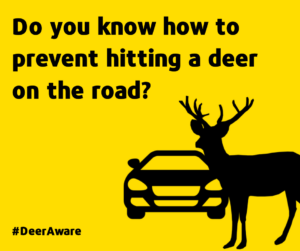 MOTORISTS in East Sussex are being urged to be ‘deer aware’ in the coming months to avoid colliding with the animals on rural roads.
MOTORISTS in East Sussex are being urged to be ‘deer aware’ in the coming months to avoid colliding with the animals on rural roads.
Every year there are an estimated 74,000 deer-related traffic collisions in the UK, with the risk of encountering the animals on the road increasing during the mating season in October and November.
East Sussex County Council is promoting social media messages using the hashtag #deeraware, based on advice from The Deer Initiative, to offer tips to help drivers stay safe on the county’s rural roads this autumn.
Deer are creatures of habit and there are deer warning signs in areas where the animals are known to cross roads regularly.
When drivers see a warning sign or are travelling through a heavily wooded stretch of road, they are advised to slow down, stay alert and be prepared to stop.
People should take particular care at night and around dawn and dusk when deer are most likely to venture out.
Cllr Claire Dowling, lead member for transport and environment, said: “We’re lucky in East Sussex to live in a largely rural county which provides an ideal habitat for deer.
“We are urging motorists to be aware that the animals may appear on the road unexpectedly at this time of year, particularly between sunset and sunrise, and the results of a collision with a deer can be very serious indeed.
“By following some simple tips, drivers can keep themselves safe and ensure these magnificent creatures can continue to roam freely and thrive in our beautiful countryside.”
Drivers are advised to use full-beam headlights at night if no other cars are around, as they will reflect the deer’s eyes, but dip their headlights when they see a deer to avoid startling it.
Deer often travel in groups so if drivers see one crossing the road they should slow down and drive with caution as others may follow.
Anyone who hits a deer is advised to stay calm, park in a safe place with hazard lights on and call the police on 101, or 999 if someone is injured or the deer is in the road.
People should not approach or try to comfort an injured deer, as it may make the animal more distressed or cause it to run back into the road.
As well as during the autumn mating season, deer are also more likely to be seen on rural roads during calving in May and June.
For more information and advice visit The Deer Initiative website at www.deeraware.com


